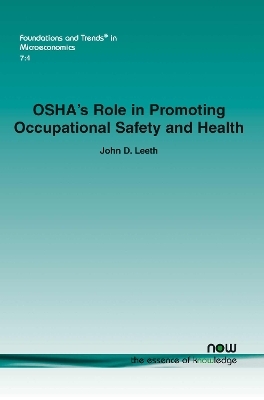
OSHA's Role in Promoting Occupational Safety and Health
Seiten
2012
now publishers Inc (Verlag)
978-1-60198-630-6 (ISBN)
now publishers Inc (Verlag)
978-1-60198-630-6 (ISBN)
Examines the four pillars of the US safety policy system with a focus on the most recent effort - the Occupational Safety and Health Administration (OSHA). The goal is to determine how OSHA could best use its limited resources to improve worker safety and health
OSHA's Role in Promoting Occupational Safety and Health examines the four pillars of the US safety policy system with a focus on the most recent effort - the Occupational Safety and Health Administration (OSHA). The goal is to determine how OSHA could best use its limited resources to improve worker safety and health in light of incentives already created through the labour market, state workers' compensation insurance programs, and the legal system. After an introduction, the next section develops the general economic model of production and the workplace when there are inevitable risks to safety and health. The third and fourth sections present the institutional details of OSHA and the nature of workplace fatalities and nonfatal injuries in the United States. The monograph moves on to examine the evolving enforcement of OSHA regulations over the forty years of its existence and the corresponding empirical estimates of its effectiveness in improving worker safety and health. The next three sections discuss the other three pillars of the US safety policy system, detailing their strengths and weaknesses in generating appropriate safety incentives. The following sections evaluate the likely impact on worker safety of expanding OSHA enforcement power and assess the cost-effectiveness of OSHA in its entirety and some of its regulations individually. The monograph concludes with recommendations on how best to improve OSHA's effectiveness in promoting worker safety and health. Finally, the author shows that no evidence exists that by magnifying OSHA's enforcement powers, either by increasing the frequency of inspections or by raising the level of fines for noncompliance, worker safety and health would improve dramatically.
OSHA's Role in Promoting Occupational Safety and Health examines the four pillars of the US safety policy system with a focus on the most recent effort - the Occupational Safety and Health Administration (OSHA). The goal is to determine how OSHA could best use its limited resources to improve worker safety and health in light of incentives already created through the labour market, state workers' compensation insurance programs, and the legal system. After an introduction, the next section develops the general economic model of production and the workplace when there are inevitable risks to safety and health. The third and fourth sections present the institutional details of OSHA and the nature of workplace fatalities and nonfatal injuries in the United States. The monograph moves on to examine the evolving enforcement of OSHA regulations over the forty years of its existence and the corresponding empirical estimates of its effectiveness in improving worker safety and health. The next three sections discuss the other three pillars of the US safety policy system, detailing their strengths and weaknesses in generating appropriate safety incentives. The following sections evaluate the likely impact on worker safety of expanding OSHA enforcement power and assess the cost-effectiveness of OSHA in its entirety and some of its regulations individually. The monograph concludes with recommendations on how best to improve OSHA's effectiveness in promoting worker safety and health. Finally, the author shows that no evidence exists that by magnifying OSHA's enforcement powers, either by increasing the frequency of inspections or by raising the level of fines for noncompliance, worker safety and health would improve dramatically.
Introduction
The Economic Model of Workplace Safety and Health
OSHA's Approach to Improving Worker Safety and Health
Safety and Health in the United States
Forty Years of OSHA Enforcement History
Market Incentives. Workers Compensation Insurance
The Legal System
Why Has OSHA Had Only a Small Impact on Worker Safety?
Is OSHA Cost Effective?
Recommendations
Conclusions
References
| Erscheint lt. Verlag | 10.12.2012 |
|---|---|
| Reihe/Serie | Foundations and Trends® in Microeconomics |
| Verlagsort | Hanover |
| Sprache | englisch |
| Maße | 156 x 234 mm |
| Gewicht | 159 g |
| Themenwelt | Betriebswirtschaft / Management ► Spezielle Betriebswirtschaftslehre ► Versicherungsbetriebslehre |
| Wirtschaft ► Volkswirtschaftslehre ► Makroökonomie | |
| Wirtschaft ► Volkswirtschaftslehre ► Mikroökonomie | |
| ISBN-10 | 1-60198-630-0 / 1601986300 |
| ISBN-13 | 978-1-60198-630-6 / 9781601986306 |
| Zustand | Neuware |
| Haben Sie eine Frage zum Produkt? |
Mehr entdecken
aus dem Bereich
aus dem Bereich
Bedarfsanalyse, Vertrags-Check, Testsieger für jede Situation, …
Buch | Softcover (2024)
Stiftung Warentest (Verlag)
CHF 20,95


